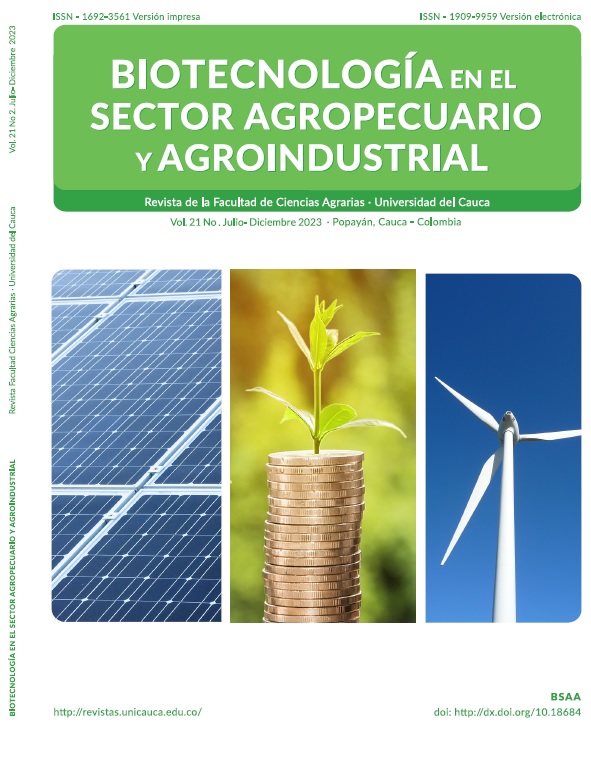Selección de rizobios eficientes en líneas de frijol común (Phaseolus vulgaris L.) tolerantes a sequía
Resumen
El rendimiento de frijol común (Phaseolus vulgaris L.) se ve limitado por condiciones de sequía prolongada y escasez de nutrientes en el suelo. La Corporación Colombiana de Investigación Agropecuaria (AGROSAVIA) seleccionó cinco genotipos de frijol común por presentar características de biofortificación, buen tamaño de grano y tolerancia al déficit hídrico, sin embargo, se requiere técnicas sostenibles que contribuyan a la adaptación de estos genotipos, y mitiguen el impacto de la sequía y escasez de nutrientes en la producción de este cultivo. Las rizobacterias promotoras de crecimiento vegetal son una alternativa para mejorar la absorción de nutrientes y la adaptación de las plantas a condiciones adversas. En este trabajo se evaluó la eficiencia de rizobios en la fijación biológica de nitrógeno (FBN) en los genotipos de frijol común seleccionados. Se tomaron muestras de suelo en la rizósfera y raíces de los cinco genotipos de frijol en el Centro de Investigación Motilonia, como también dos muestreos alternativos en otras zonas del departamento del Cesar. Se utilizaron las semillas de frijol como trampa para obtener nódulos en el laboratorio. También se evaluó la nodulación y la FBN de 11 cepas del banco de AGROSAVIA en los cinco genotipos de frijol y se midió la eficiencia simbiótica de 7 de las cepas en cuatro de los genotipos. Se obtuvieron 3 aislados con características de rizobios, simbiontes del genotipo 77-SMG22. Las cepas más eficientes en la FBN fueron la P17 y P22 en el genotipo 45-HTA10-2, las cepas C229 y P37 en el 48-HTA14-1, en el genotipo 56-DAB295 todas las cepas simbiontes fueron eficientes (C229, P03, P22 Y P37), y en el genotipo 77-SMG22 el tratamiento más eficiente fue el inoculante comercial Rhizobiol®. Por tanto, las cepas del banco de AGROSAVIA promueven el desarrollo de algunos genotipos de frijol común reflejado en el crecimiento de las plantas.
Descargas
Disciplinas:
Microbiología del sueloLenguajes:
Español; CastellanoReferencias bibliográficas
AGRONET. RED DE INFORMACIÓN Y COMUNICACIÓN DEL SECTOR AGROPECUARIO COLOMBIANO. Reporte: Area, producción y rendimiento nacional por cultivo. Agronet, MinAgricultura, 2020.https://www.agronet.gov.co/estadistica/Paginas/home.aspx?cod=1 [consultado el…..]
AGUILERA, EDUARDO.; PIÑERO, PABLO; INFANTE-AMATE, JUAN; GONZÁLEZ-DE MOLINA, MANUEL; LASSALETTA, LUIS; SANZ-COBEÑA, ALBERTO. Emisiones de gases de efecto invernadero en el sistema agroalimentario y huella de carbono de la alimentación en España. Madrid (España): Real Academia de Ingeniería, 2020.
ALEMNÉH, A.A; ZHOU, Y; RYDER, M.H; DENTON, M.D. Mechanisms in plant growth‐promoting rhizobacteria that enhance legume–rhizobial symbioses. Journal of Applied Microbiology, v. 129, n. 5, 2020, p. 1133-1156.https://doi.org/10.1111/jam.14754
ANGELES-NÚÑEZ, JUAN-GABRIEL; CRUZ-ACOSTA, TERESA. Aislamiento, caracterización molecular y evaluación de cepas fijadoras de nitrógeno en la promoción del crecimiento de frijol. Revista mexicana de ciencias agrícolas, v. 6, n. 5, 2015, p. 929-942.
ASERSE, AREGU-AMSALU; MARKOS, DANIEL; GETACHEW, GENET; YLI-HALLA, MARKKU; LINDSTRÖM, KRISTINA. Rhizobial inoculation improves drought tolerance, biomass and grain yields of common bean (Phaseolus vulgaris L.) and soybean (Glycine max L.) at Halaba and Boricha in Southern Ethiopia. Archives of Agronomy and Soil Science, v. 66, n. 4, 2020, p. 488-501.https://doi.org/10.1080/03650340.2019.1624724
BEEBE, STEPHEN. Common bean breeding in the tropics. En JANICK, JULIO, Plant breeding reviews, v. 36, 2012, p. 357-426.https://doi.org/10.1002/9781118358566.ch5
BETTIOL-TROMBETA, JOÃO-VICTOR; FILLA, VINICIUS-AUGUSTO; LEAL, FABIO-TIRABOSCHI; COELHO, ANDERSON-PRATES; MEIRELLES, FLAVIA-CONSTANTINO; LEMOS, LEANDRO-BORGES; BOSSOLANI, JOÃO-WILLIAM. Sustainable production of common beans: inoculation, co-inoculation and mineral fertilization in early-cycle cultivars. Journal of Plant Nutrition, v. 44, n. 1, 2020, p. 16-28.https://doi-org.biblioteca.unimagdalena.edu.co/10.1080/01904167.2020.1822403
BIANCO, LUCIANA. Principales aspectos de la nodulación y fijación biológica de nitrógeno en Fabáceas. Idesia (Arica), v. 38, n. 2, 2020, p. 21-29.http://dx.doi.org/10.4067/S0718-34292020000200021
BROCKWELL, J.; HELY, W.; NEAL, SMITH. A Some symbiotic characteristics of rhizobia responsible for spontaneous, effective field nodulation of Lotus hispidus. Australian Journal of Experimental Agriculture and Animal Husbandry, v. 6, n. 23, 1966, p. 365-370.https://doi.org/10.1071/EA9660365
BURBANO-ERAZO, ESTEBAN; LEÓN-PACHECO, ROMER-IGOR; CORDERO-CORDERO, CARINA-CECILIA; LÓPEZ-HERNÁNDEZ, FELIPE; CORTÉS, ANDRES J.; TOFIÑO-RIVERA, ADRIANA-PATRICIA. Multi-environment yield components in advanced common bean (Phaseolus vulgaris L.)× tepary bean (P. acutifolius A. Gray) interspecific lines for heat and drought tolerance. Agronomy, v. 11, n. 10, 2021.https://doi.org/10.3390/agronomy11101978
COLOMBIA. INSTITUTO COLOMBIANO AGROPECUARIO (ICA). Productos Bioinsumos Registrados. Colombia, 2021.https://www.ica.gov.co/getdoc/2ad9e987-8f69-4358-b8a9-e6ee6dcc8132/productos-bioinsumos-mayo-13-de-2008.aspx
COSTA, MAIRA-REJANE; CHIBEBA, AMARAL-MACHACULEA; MERCANTE, FABIO-MARTINS; HUNGRIA, MARIANGELA. Polyphasic characterization of rhizobia microsymbionts of common bean [Phaseolus vulgaris (L.)] isolated in Mato Grosso do Sul, a hotspot of Brazilian biodiversity. Symbiosis, v. 76, n. 2, 2018, p. 163-176. https://doi.org/10.1007/s13199-018-0543-6
CUBILLOS-HINOJOSA, JUAN-GUILLERMO; SACCOL-DE SÁ, ENILSON-LUIZ; DA SILVA-ARAUJO, FERNANDA. Efficiency of rhizobia selection in Rio Grande do Sul, Brazil using biological nitrogen fixation in Phaseolus lunatus. African Journal of Agricultural Research, v. 17, n. 2, 2021, p. 229-237.https://doi.org/10.5897/AJAR2020.15066
DA SILVA, JOSE-GERALDO; DE BRITO-FERREIRA, ENDERSON-PETRONIO; DAMIN, VIRGINIA; NASCENTE, ADRINAO-STEPHAN. Response of the common bean to liquid fertilizer and Rhizobium tropici inoculation. Semina: Ciências Agrárias, v. 41, n. 6, 2020, p.2967-2976.http://dx.doi.org/10.5433/1679-0359.2020v41n6Supl2p2967
DEBOUCK, DANIEL; SANTAELLA, MARCELA; SANTOS, LUIS-GUILLERMO. “History and impact of a bean (Phaseolus spp., Leguminosae, Phaseoleae) collection”, Genetic Resources, v. 2, n.4, 2021, p. 21-43. https://doi.org/10.46265/genresj.WJEU8358
FAOSTAT. ORGANIZACIÓN DE LAS NACIONES UNIDAS PARA LA ALIMENTACIÓN Y LA AGRICULTURA. Datos sobre alimentación y agricultura, 2021. https://www.fao.org/faostat/es/#data/QCL [Consultado el 10 de enero de 2021]
GRANDA-MORA, IVAN-KLEVER; NÁPOLES-GARCÍA, MARIA-CARIDAD; ROBLES-CARRIÓN, ÁNGEL-ROLANDO; ALVARADO-CAPÓ, YELENYS; TORRES GUTIÉRREZ, RONAL. Respuesta de Phaseolus vulgaris cv. Mantequilla a la inoculación de cepas de Rhizobium nativas de Ecuador en casas de cultivo. Centro Agrícola, v. 43, n. 4, 2016, p. 49-56.
GUNNABO, ASHENAFI-HAILU; GEURTS, RENE; WOLDE-MESKEL, ENDALKACHEW; DEGEFU, TULU; GILLER, KEN-E; HEERWAARDEN, JOOST-VAN. Phylogeographic distribution of rhizobia nodulating common bean (Phaseolus vulgaris L.) in Ethiopia. FEMS Microbiology Ecology, v. 97, n. 4, 2021, p. 1-16. https://doi.org/10.1093/femsec/fiab046
GUNNABO, ASHENAFI-HAILU; HEERWAARDEN, JOOST-VAN; GEURTS, RENE; WOLDE-MESKEL ENDALKACHEW; DEGEFU, TULU; GILLER, KEN-E. Symbiotic interactions between chickpea (Cicer arietinum L.) genotypes and Mesorhizobium strains. Symbiosis, v. 82, 2020, p. 235–248.https://doi.org/10.1007/s13199-020-00724-6
GUZMÁN-DUCHEN, DANIEL; MONTERO-TORRES, JULIO. Interacción de bacterias y plantas en la fijación del nitrógeno. Revista De Investigación E Innovación Agropecuaria Y De Recursos Naturales, v. 8, n. 2, 2021, p.87-101.https://doi.org/10.53287/uyxf4027gf99e
HOAGLAND, R; ARNON, I. The water-culture method for growing plants without soil. Berkeley. University of California, 1950, 32 p.
JIMÉNEZ, OSWALT. R.; Common Bean (Phaseolus vulgaris L.) Breeding. En Al-Khayri, J. M. Jain S. M.; Johnson D. V; Advances in Plant Breeding Strategies: Legumes, v. 7. 2019, 151-200 p.https://doi.org/10.1007/978-3-030-23400-3_5
LÓPEZ-ALCOCER, JOSE-DE JESUS; LÉPIZ-ILDEFONSO, ROGELIO; GONZÁLEZ-EGUIARTE, DIEGO-RAYMUNDO; RODRÍGUEZ-MACÍAS, RAMON; LÓPEZ-ALCOCER, EDUARDO. Eficiencia en fijación biológica de nitrógeno de cepas de Rhizobium spp. recolectadas en frijol cultivado y silvestre. Terra Latinoamericana, v. 38, n. 4, 2020, p. 841-852. https://doi.org/10.28940/terra.v38i4.654
LOSA, ALESSIA; VORSTER, JUAN; COMINELLI, ELEONORA; SPARVOLI, FRANCESCA; PAOLO, DARIO; SALA, TEA; MARIKA, FERRARI; CARBONARO, MARINA; MARCONI, STEFANIA; CAMILLI, EMANUELA; REBOUL, EMMANUELLE; WASWA, BOAZ; EKEZA, BEATRICE; ARAGÃO, FRANCISCO; KUNERT, KARL. Drought and heat affect common bean minerals and human diet—What we know and where to go. Food and Energy Security, v. 11, n. 1, 2022, p. 1-28. https://doi.org/10.1002/fes3.351
MILCHESKI, VIVIANE-DE FATIMA; SENFF, SINDI-ELEN; ORSI, NICOLE; BOTELHO, GLORIA-REGINA; FIOREZE-DA COSTA LARA, ANA-CAROLINA. Influência da interação entre genótipos de feijoeiro e rizóbios na nodulação e fixação de nitrogênio. Revista de Ciências Agroveterinárias, Lages, v. 21, n. 1, 2022, p. 8-15.https://doi.org/10.5965/223811712112022008
MOURA, FERNANDA-TEREZINHA; RIBEIRO, RENAN-AUGUSTO; HELENE, LUISA-CAROLINA; NOGUEIRA, MARCO-ANTONIO; HUNGRIA, MARIANGELA. So many rhizobial partners, so little nitrogen fixed: The intriguing symbiotic promiscuity of common bean (Phaseolus vulgaris L.). Symbiosis, v. 68, 2022, p. 168-185. https://doi.org/10.1007/s13199-022-00831-6
NADEEM, MUHAMMAD-AZHAR; YEKEN, MEHEMET-ZAHIT; SHAHID, MUHAMMAD-QASIM; HABYARIMANA, EPHREM; YILMAZ, HILAL; ALSALEH, AHMAD; HATIPOĞLU; RÜŞTÜ; ÇILESIZ, YETER; KHAWAR, KHALID-MAHMOOD; LUDIDII, NDIKO; ERCIŞLI, SEZAI; AASIMA, MUHAMMAD; KARAKÖYA, TOLGA; BALOCH, FAHEEM-SHEHZAD. Common bean as a potential crop for future food security: an overview of past, current and future contributions in genomics, transcriptomics, transgenics and proteomics. Biotechnology & Biotechnological Equipment, v. 35, n. 1, 2021, p.759-787.https://doi.org/10.1080/13102818.2021.1920462
PÀDUA-OLIVEIRA, DAMIANY; RUFINI, MARCIAA; DIAS-MARTINS, FABIO-AURELIO; SAVANAA-DA SILVA, JACQUELINE; DA SILVA-ARAGÃO, OSCAR-OBEDE, DE SANTANA, MARCIO-JOSE; BASTOS-DE ANGRADE, MESSIAS-JOSE; DE SOUZA-MOREIRA, FATIMA-MARIA. Inoculation with Rhizobium tropici can totally replace N-fertilization in the recently released BRSMG Uai bean cultivar. Acta Scientiarum Agronomy, v. 44, 2022, p. 1-8.https://doi.org/10.4025/actasciagron.v44i1.52475
PATRA, DIPANWITA; MANDAL, SUKHENDU. Nod–factors are dispensable for nodulation: A twist in bradyrhizobia-legume symbiosis. Symbiosis, v. 86, n. 1, 2022, p. 1-15.https://doi.org/10.1007/s13199-021-00826-9
REINPRECHT, YARMILLA; SCHRAM, LYNDSAY; MARSOLAIS, FRÉDÉRIC; SMITH, THOMAS-H; HILL, BRETT; PAULS, KARL-PETER. Effects of nitrogen application on nitrogen fixation in common bean production. Frontiers in plant science, v. 11, n. 1172, 2020, p. 1-19.https://doi.org/10.3389/fpls.2020.01172
ROJAS, PAOLA-BRENES; CORDERO, JUAN-JOSÉ; PEÑA-CORDERO, WAGNER. Efecto de la fertilización nitrogenada sobre la nodulación de arveja en un suelo andisol de La Angelina, Cartago. Repertorio Científico, v. 24, n. 2, 2021, p. 8-14.https://doi.org/10.22458/rc.v24i2.3888
SAMBANGI, PRATYUSHA; SRINIVAS, VADLAMUDI; GOPALAKRISHNAN, SUBRAMANIAM. Understanding the Evolution of Plant Growth-Promoting Rhizobacteria. In SHRIVASTAVA, NEERAJ; MAHAJAN, SHUBHANGI; VARMA, AJIT. Symbiotic Soil Microorganisms. Soil Biology, v. 60, 2021, p. 187-200.https://doi.org/10.1007/978-3-030-51916-2_12
SANTOYO-PIZANO, GUSTAVO; HERNÁNDEZ-MENDOZA, JOSE-LUIS; MÁRQUEZ-BENAVIDES, LILIANA; LUNA-ESQUIVEL, GUSTAVO; SÁNCHEZ-YÁÑEZ, JUAN-MANUEL. Rhizobium phaseoli tolerante a un insecticida en el crecimiento de Phaseolus vulgaris. Revista de la Sociedad de Investigación Selva Andina, v. 12, n, 1, 2021, p. 30-37.https://doi.org/10.36610/j.jsars.2021.12010030
SHAMSELDIN, ABDELAAL; VELÁZQUEZ, ENCARNA. The promiscuity of Phaseolus vulgaris L. (Common bean) for nodulation with rhizobia: a review. World Journal Microbiology Biotechnology, v. 36, n. 63, 2020, p. 1-12.https://doi.org/10.1007/s11274-020-02839-w
SHANKAR, SIRIAM; HAQUE, EKRAMUL; AHMED, TANVEER; KIRAN, JORGE-SEGHAL. HASSAN, SAQIB; SELVIN, JOSE. Rhizobia–Legume Symbiosis During Environmental Stress. En In SHRIVASTAVA, NEERAJ; MAHAJAN, SHUBHANGI; VARMA, AJIT; Symbiotic Soil Microorganisms, v. 60, 2021. p. 201-220.https://doi.org/10.1007/978-3-030-51916-2_13
SILVEIRA, J.; CONTADO, J.; RODRIGUES, J.; OLIVEIRA, J. Phosphoenolpyruvate carboxylase and glutamine synthetase activities in relation to nitrogen fixation in cowpea nodules. Revista Brasileira de Fisiologia Vegetal (Brazil), 1998.https://doi.org/10.1590/S0103-31312000000300003.
SOMASEGARAN, PADMA.; HOBEN, HEINZ. Cultural Properties, Cell Morphology, and Nutritional Requirements of Rhizobia. In: Handbook for Rhizobia. New York (United States Of America): Springer,1992; 31-37 p. https://doi.org/10.1007/978-1-4613-8375-8_3 2012
SOTO-VALENZUELA, JAVIER; CATUTO-SUÁREZ, ANDREA; ÁLVAREZ-VERA, MANUEL. Evaluación del crecimiento y nodulación de plantas de soja (Glycine max) inoculadas con Rhizobium y Bradyrhizobium japonicum en Manglaralto, Santa Elena (Ecuador). Revista Científica y Tecnológica UPSE, v. 8, n. 2, 2021, p. 27-32. https://doi.org/10.26423/rctu.v8i2.577
STEINER, FABIO, DA SILVA-OLIVEIRA, CARLOS-EDUARDO; ZOZ, TIAGO; ZUFFO, ALAN-MARIO; DE FREITAS-SOARES, ROGELIO. Co-inoculation of common bean with Rhizobium and Azospirillum enhance the drought tolerance. Russian Journal of Plant Physiology, v. 67, n. 5, 2020, p. 923-932. https://doi.org/10.1134/S1021443720050167
SUAREZ, JUAN-CARLOS; POLANÍA, JOSÉ; CONTRERAS, AMARA; RODRÍGUEZ, LEONARDO; MACHADO, LEIDY; ORDOÑEZ, CLAUDIA; BEEBE, STEVEN; RAO, I. Adaptation of common bean lines to high temperature conditions: genotypic differences in phenological and agronomic performance. Euphytica, v. 216, n. 28, 2020.https://doi.org/10.1007/s10681-020-2565-4
TORRES-GUTIÉRREZ, RONAL.; GRANDA-MORA, KLEVER-IVAN.; BAZANTES-SANTOS, KASSANDRA-DEL ROCIO.; ROBLES-CARRIÓN, ANGEL. Rhizobium Diversity Is the Key to Efficient Interplay with Phaseolus vulgaris. En MADDELA, NAGA-RAJU.; GARCÍA-CRUZATTY, LUZ.; CHAKRABORTY, SAGNIK. Advances in the Domain of Environmental Biotechnology, 2021, 521-548 p.https://doi.org/10.1007/978-981-15-8999-7_19
VALERO-VELERO, NELSON-OSVALDO; CASTRO-VERGEL, CLAUDIA-MARCELA; USTATE-MORALES, YEISON-ENRIQUE; GÓMEZ-GÓMEZ, LILIANA-CECILIA. Bioestimulación de frijol guajiro y su simbiosis con Rhizobium por ácidos húmicos y Bacillus mycoides. Biotecnología En El Sector Agropecuario Y Agroindustrial, v. 19, n. 2, 2021, p. 154-169. https://doi.org/10.18684/bsaa.v19.n2.2021.1608
VILLANUEVA, NERY-SANTILLANA. Mecanismos de inducción de rizobios para reducir el estrés por sequía en las leguminosas. Revista de Investigaciones Altoandinas, v. 23, n. 4, 2021, p. 258-265. http://dx.doi.org/10.18271/ria.2021.263
VINCENT, J.M. A manual for the practical study of root-nodule bacteria. International Biological Programme. Oxford (United Kingdom): Blackwell scientific, 1970, 164 p.
WEKESA, CLABE-SIMIYU; FURCH, ALEXANDRA; OELMÜLLER, RALF. Isolation and characterization of high-efficiency rhizobia from Western Kenya nodulating with Common bean. Frontiers in microbiology, v. 12, 2021, p. 1-13.https://doi.org/10.3389/fmicb.2021.697567
ZHENG, WEN-TAO; LI JR, YING; WANG, RUI; SUI, XIN-HUA; ZHANG, XIAO-XIA; ZHANG, JUN-JIE; WANG, EN-TAO; CHEN, WEN-XIN. Mesorhizobium qingshengii sp. nov., isolated from effective nodules of Astragalus sinicus. International journal of systematic and evolutionary microbiology, v. 63, n. 6, 2013, p. 2002-2007.https://doi.org/10.1099/ijs.0.044362-0
Derechos de autor 2023 Universidad del Cauca

Esta obra está bajo una licencia internacional Creative Commons Atribución-NoComercial-SinDerivadas 4.0.


 Español
Español Inglés
Inglés





















.png)



